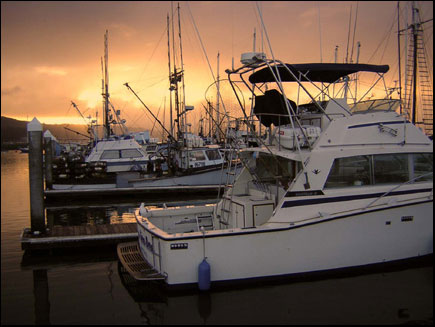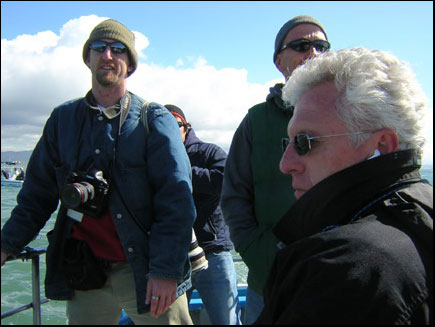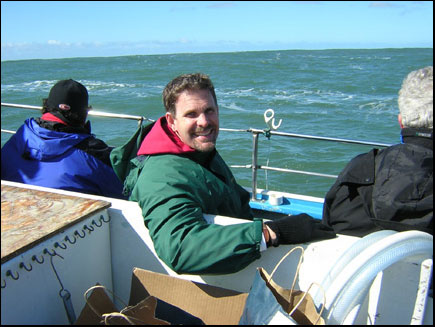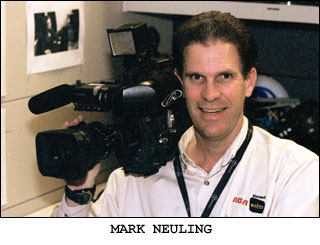Mavericks – Not
Made for TV
By Mark Neuling
Photojournalist for TechTV
Friday
February 27, 2004
It was just past 6 a.m. when I pulled into the Albertson’s
parking lot in Half Moon Bay. As I was getting my gear ready in
the back of the car a slow drizzle began. I didn’t know
if this was to be a portent for the rest of the day or not, but
I
hastily finished arranging my equipment and got back in the car.
My watch said 6:13 a.m.
I was to meet with Becky Worley and another freelance cameraman
at a quarter
past six. Since “Becky-time” is usually 20 minutes late I reclined
my seat and closed my eyes. A minute or two later Worley’s big black Ford
cruises past my car and circles, shark-like, on the glistening parking lot pavement.
Will wonders never cease I think to myself, Becky is actually on time. I crank
over my engine and follow her to a parking space a short distance away. The other
shooter meets us and we hold a brief meeting in a small coffee shop that’s
probably only been open for a few minutes.
We’ve never worked with this particular shooter; I had only met him the
day before. He’s far more alert and awake than I am. Worely buys a muffin
and some water and then briefs him on the shoot and what she’s looking
for.
The day before The Mavericks Surf Contest was given the green
light. The contest is held anytime from December 15th through
March 31st. It’s supposed to
be a yearly contest but hasn’t been held for several years due to the
lack of big surf as well as the lack of a sponsor. After studying surf conditions
using a variety of buoy information, satellite photos and weather charts, Jeff
Clark the Contest Director, places a call to two dozen of the best big-wave
surfers
in the world. They have 24 hours to make their way to Half Moon Bay, California;
about an hours drive south of San Francisco.
The waves they will be surfing can crest at 50 feet or more.
They break about a half mile off-shore on a shallow reef.
One surfer was killed
at this contest
in December of 1994. The prize money for first place is five thousand
dollars.
Becky and I will be on the media boat. The other photographer
will be shooting the surf contest from the cliffs above
the beach. She
also wants
him to
get some reaction shots of the crowd as they oh and ah over the
action. I wash
a Dramamine
down with some of her water.
After getting our media credentials our little band splits
up, Worley and I head to the media boat where the photographers
and
reporters
can watch
the
heats from
a distance of 100 meters or so. It is an interesting collection
of people and gear; most are in their late 20's to early 30's,
only
four or five
of us are
past 40. Many seem to have surfer backgrounds. Cameras range
from point and shoot digitals to medium format, there are
only two of
us onboard
with broadcast
television
cameras.
Worley and I have had bad luck around water with our gear.
She has been admonished by our news director to bring back
all the
gear.
I remind
her that we always
bring our equipment back; it just isn’t all working when we return.
We
board a dowager party/fishing boat out of Pillar Point
Harbor.
A pot of coffee is brewing in the galley. The captain of
the vessel gives a brief safety
lecture, one I can tell he’s done many times. Two comments stand out.
The lavatories are to be used for only two things, if you have to vomit,
do it over the side. Becky prays under her breath that she doesn’t
throw up. His other piece of advice is one that most sailors will know, one
hand for the boat and one hand for you. With that we set sail shortly after
dawn, the rain has stopped and the harbor is calm. It’s the last smooth
water we’ll see for the next seven hours. |

| Dawn breaks over Pillar Point Harbor the day
of The Mavericks Surf
Contest. February 27, 2004.
©Mark Neuling 2004
|
|
Photographers
have a pack mentality. Most of us head to the front of the boat
to vie for camera positions. Everyone’s adrenaline is up.
The boat begins to pitch and yaw; there are nervous jokes about “The
Perfect Storm.” I
shoot a few minutes of tape. The captain comes on the PA, “There
will be a little rough water once we leave the breakwater," yeah
no kidding I think. I decide to sit on a bench beneath
the wheelhouse and wait until we’re
farther out. I grip my camera by its handle and rest it
in my lap and frame a shot of one of the other photographers
silhouetted at the bow of the boat. I
roll on the shot for five or six seconds when the right
side of the boat suddenly lifts. The bench I’m sitting
on has unexpectedly become a roller coaster ride without
any seatbelt, my camera flips on it’s side and I
somehow mange to get my left leg underneath me to prevent
being dumped on the deck. One young
woman asks me if I’m alright, she won’t be
the first person this day to ask about my well being.
Once my brief rodeo ride is over I decide to check the
video to see what it looked like from the camera’s perspective. I hit rewind, nothing happens,
a red light flashes, the camera has jammed.
Cameras have personalities and quirks. Even though mine
is beat up and scarred it’s only failed me once in two years. The engineers say there is nothing
wrong with the deck, it’s the recycled tapes we use, but there is a strange
juju between my camera and Worley. This only happens on her shoots. I turn the
camera off and let it rest for a few seconds. When I power it up again the red
light is off. I hit the eject button, the door opens and the DVCPRO cassette
pops out. I carefully inspect the tape and then gently load it back in the deck.
I can hear the heads threading the tape; we’ve just dodged the biggest
bullet we’ll face all day.
When we reach the competition area about a half-mile
off-shore there is an armada of boats the likes of
which haven’t been seen since Dunkirk. Party
boats, fishing boats, one lone sail boat tacking back and forth and dozens
of zodiacs
and jet-skis. Most of which have at least one photographer shooting stills
or video.
A helicopter circles the area throughout the day
with a cameraman shooting from the open door. At
one point
the
chopper pilot
makes a low-level,
head on pass
at the waves, barely skimming over their crests.
He must be getting spray on his windshield I think.
Fingers
of
foam reach
upwards
towards the
chopper issuing
a challenge; don’t fly so low or we will pull you in. Worley knows a chopper
pilot in Maui who twice has gone in the drink. For the rest of the day the pilot
maintains a healthy altitude. Still, it feels like a scene from “Apocalypse
Now.”
As
the competition starts I again make my way to the railing. I
envy the still photographers. They are like cowboys riding a
Brahma bull. They grip the rail with one hand and shoot with
the other, firing off four or five frame bursts. These modern
auto-everything cameras, sigh.

Two awesome newspaper photographers,
Mathew Sumner (L) of the San Mateo County Times and
Frederic Larson (R) of the San Francisco Chronicle.
©Mark Neuling 2004
|
|
But
I need two hands on my big camera, so I decide to try and
shoot from my knees; it works for football
and basketball, why not surfing. But
the boat slams from
wave to wave, I’m getting poor shots and nausea has settled in my
stomach. I call a retreat to the back of the boat. As we make our way amidships
I
look down at the palm of my right hand, the base of my ring finger is black
and
blue. I had gripped the camera so hard when I was slammed on the bench
that I bruised
my hand.
|
In between
heats there is time to take a break. Worley watches over my camera
as I make my way to the back of the boat. I’m giving in
to the ball of nausea that is slowly churning inside. I lean
over the side and gag once or twice. Surprisingly little comes
out, I’ve actually managed to keep most of my breakfast
down, but I only feel a little better.
I
go back to bench and sit, out of the game. There is one
other TV photographer on board the boat, he’s lugging
a big Ikegami BETACAM. I don’t
know what station he’s with but he joins me and we compare notes.
He too has had a difficult time framing shots in the heavy seas. And every
time we do get a clean shot of a surfer he disappears in a trough or another
boat blocks our view. He admits to feeling sick as well. Several years
back a CNN crew begged to get off the media boat.
|

The author feeling a whiter shade
of pale.
Photo courtesy of
Becky Worley. |
|
The
wipe-out of the day happens before us. Several surfers catch
the face of a wave
and are suddenly
pitched forward
into the
maelstrom. Their colorful
boards spin on end making for a dramatic
wipe-out. Neither of us lifts
our camera to
record it.
I’ve forced myself not to look at my watch, but the hours have passed and
I need to use the head. I can barely turn around in the closet size bathroom.
As I fumble with the layers of clothing I’m wearing the boat lurches
and the lid to the toilet slams shut. Oh this could be very interesting I think
if
that happens again. But I manage to take care of my business without further
incident. It was the steadiest shot I made all day.
I duck inside the small cabin to warm up.
It looks like a triage. The coffee-maker
is splayed
in the
sink, the
coffee
grounds
spread about
like shrapnel.
One woman sits, head in her hands, eyes
tightly closed. I can’t imagine what she’s
thinking. Another photographer reclines on one of the benches with a shiny new
Nikon in her lap. Occasionally throughout the day she’ll make her way
on deck, fire off a few frames and then withdraw back inside. Several others
eventually
join them. I actually feel better on deck.

TechTV reporter Becky Worley.
©Mark Neuling 2004
|
|
Becky
offers me some crackers and a cookie. I only nibble at
them. She passes me some water and another Dramamine. While
she’s sitting next to me I begin to shiver. The chills,
like contractions, had been coming sooner and lasting longer.
From out of nowhere she produces a fleece vest for me to
wear. She peels off her gloves and gives them to me. “You
have to hold the camera,” she says. I have now been
broken down completely, reduced to wearing women’s
clothing. |
But as the morning passes into afternoon
and the tide comes in, the waves
drop a little, there is
less wind
and it
feels warmer.
I finally
get
my sea-legs; the knot of nausea in
my stomach has finally unraveled.
I feel
like I’ve
just gotten over a bout of the flu.
Worley and I go to work for the remaining
heats and the finals. I brace my
self against a bulkhead
amidships.
As I follow
the surfers beginning
their
plunge
down the walls of water she spots
who will be following next into
the abyss.
I hear
her time
and again
say “inside” or “outside”.
I just pan back and forth and don’t have to search very hard for the
next rider. Finally we start to get some decent shots.
The ride back to the harbor seems
to take no time, the ocean feels
like
glass.
Back at Becky’s truck we hook up with the cameraman we had on shore. He’s
sunburned but effervescent about the footage he’s gotten. The freelancer
has recorded lots of terrific sequences from the competition as well as fantastic
shots of the crowd lining the beach. Worley seems pleased. He’s stoked
about his days work. I just quietly stow my gear away. It wasn’t my day
to get the game winning hit. After he’s left I confess to Becky that I
feel like I let her down. But a great reporter like Becky crafts the perfect
ending. “You fought your way back,” she reminds me.
That night I’m dog tired, my legs ache and I sleep for ten hours. This
day has given a new meaning to the term “newspuke.”
Mark
Neuling
© Mark Neuling 2004
The opinions expressed are solely those of the author.
Email info: markneuling@techtvcorp.com
TechTV is the world’s leading cable and satellite television
channel covering technology news, information, and entertainment from
a consumer, industry, and market perspective 24 hours a day. Available
in more than 75 million households across 70 countries, TechTV is also
the world’s largest producer and distributor of programming
about technology.
Copyright TechTV 2003 TechTV Inc. All rights reserved.





